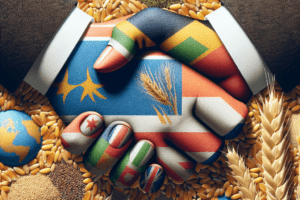Exploring the cultural significance of grain crops reveals their profound impact on human civilization, shaping diets, economies, and social structures throughout history. Grains, such as wheat, rice, corn, and barley, have not only served as staple foods but have also played crucial roles in rituals, traditions, and the development of societies. This article delves into the multifaceted roles that grain crops have played across different cultures and epochs, highlighting their importance in both historical and contemporary contexts.
The Historical Role of Grains in Civilization
Grains have been cultivated for thousands of years, with evidence of their domestication dating back to the Neolithic period. The transition from nomadic lifestyles to settled agricultural communities marked a significant turning point in human history. This shift allowed for the establishment of permanent settlements, leading to the rise of complex societies.
The Birth of Agriculture
The domestication of grain crops was a pivotal moment in the development of agriculture. Early civilizations, such as those in Mesopotamia, Egypt, and the Indus Valley, relied heavily on grains for sustenance. Wheat and barley were among the first crops to be cultivated, providing essential calories and nutrients. The ability to produce surplus food enabled these societies to support larger populations and facilitated trade.
- Mesopotamia: Often referred to as the „Cradle of Civilization,” Mesopotamia saw the emergence of agriculture around 10,000 BCE. The Sumerians developed advanced farming techniques, including irrigation, which allowed for the cultivation of wheat and barley in the fertile land between the Tigris and Euphrates rivers.
- Ancient Egypt: The Nile River’s annual flooding provided fertile soil for growing grains, particularly emmer wheat and barley. These crops were central to the Egyptian diet and played a significant role in their religious practices, as bread and beer were staples in their culture.
- Indus Valley Civilization: Archaeological evidence suggests that the people of the Indus Valley cultivated wheat and barley as early as 7000 BCE. These grains were integral to their diet and trade networks, influencing the region’s economic development.
Grains and Social Structures
The cultivation of grains not only transformed diets but also influenced social hierarchies and governance. The surplus generated from grain production allowed for the specialization of labor, leading to the emergence of various professions and social classes. Rulers and elites often controlled grain production and distribution, which became a source of power and wealth.
- Feudal Systems: In medieval Europe, grain production was central to the feudal system. Lords owned vast tracts of land where peasants worked to produce grains, which were then used to sustain the local economy and support the ruling class.
- Trade and Commerce: Grains became a valuable commodity in trade, leading to the establishment of trade routes and markets. The exchange of grain not only facilitated economic growth but also cultural exchange between different civilizations.
The Cultural Significance of Grains
Beyond their nutritional value, grains hold deep cultural significance in various societies. They are often intertwined with traditions, rituals, and identities, reflecting the values and beliefs of different cultures.
Grains in Religion and Rituals
Many cultures have incorporated grains into their religious practices and rituals. Grains are often seen as gifts from the gods, symbolizing fertility, abundance, and sustenance. They play a crucial role in various ceremonies, from harvest festivals to religious offerings.
- Harvest Festivals: Many cultures celebrate the harvest of grains with festivals that honor the earth and the deities associated with agriculture. For example, the Japanese celebrate „Niinamesai,” a festival that expresses gratitude for the rice harvest.
- Religious Offerings: In ancient Greece, grains were offered to the gods during religious ceremonies. The Eleusinian Mysteries, which celebrated the goddess Demeter and her daughter Persephone, included rituals centered around the harvest of grains.
Grains in Culinary Traditions
Grains are fundamental to the culinary traditions of many cultures, serving as the basis for a wide variety of dishes. From bread and pasta to rice and porridge, grains are versatile ingredients that have been adapted to local tastes and customs.
- Bread: Often referred to as the „staff of life,” bread made from wheat is a staple in many cultures. Each region has its unique bread-making traditions, reflecting local ingredients and techniques.
- Rice Dishes: In Asian cultures, rice is a central component of daily meals. It is often served in various forms, from steamed rice to rice noodles, and is integral to many traditional dishes.
- Corn in the Americas: Corn, or maize, is a vital crop in many Indigenous cultures in the Americas. It is used to make tortillas, tamales, and various other dishes, symbolizing sustenance and cultural identity.
Modern Implications of Grain Cultivation
In contemporary society, the significance of grains continues to evolve. With the rise of globalization and industrial agriculture, the dynamics of grain production and consumption have changed dramatically. However, the cultural importance of grains remains steadfast.
Globalization and Grain Trade
The globalization of grain markets has transformed the way grains are produced, traded, and consumed. Large-scale agricultural practices have led to increased efficiency and productivity, but they have also raised concerns about sustainability and food security.
- Monoculture Practices: The focus on a few staple grains, such as wheat, rice, and corn, has led to monoculture practices that can deplete soil health and biodiversity. This has sparked discussions about the need for sustainable agricultural practices that prioritize crop diversity.
- Food Security: The reliance on a limited number of grain crops poses risks to food security, particularly in regions vulnerable to climate change and economic instability. Efforts to promote local grain production and consumption are gaining traction as a means to enhance resilience.
Grains and Health Trends
In recent years, there has been a growing interest in the health implications of grain consumption. The rise of gluten-free diets and the popularity of ancient grains have sparked debates about the nutritional value of different types of grains.
- Gluten-Free Movement: The increasing awareness of gluten intolerance and celiac disease has led to a surge in gluten-free products. This trend has prompted a reevaluation of traditional grain consumption and has encouraged the exploration of alternative grains.
- Ancient Grains: Grains such as quinoa, farro, and spelt have gained popularity for their nutritional benefits and unique flavors. These ancient grains are often touted for their higher protein content and health-promoting properties.
Conclusion
The cultural significance of grain crops is deeply rooted in human history and continues to shape our societies today. From their role in the development of agriculture and social structures to their importance in religious rituals and culinary traditions, grains have been integral to the human experience. As we navigate the complexities of modern agriculture and food systems, it is essential to recognize and honor the cultural heritage associated with these vital crops. Understanding the past and present significance of grains can guide us toward a more sustainable and culturally aware future.













